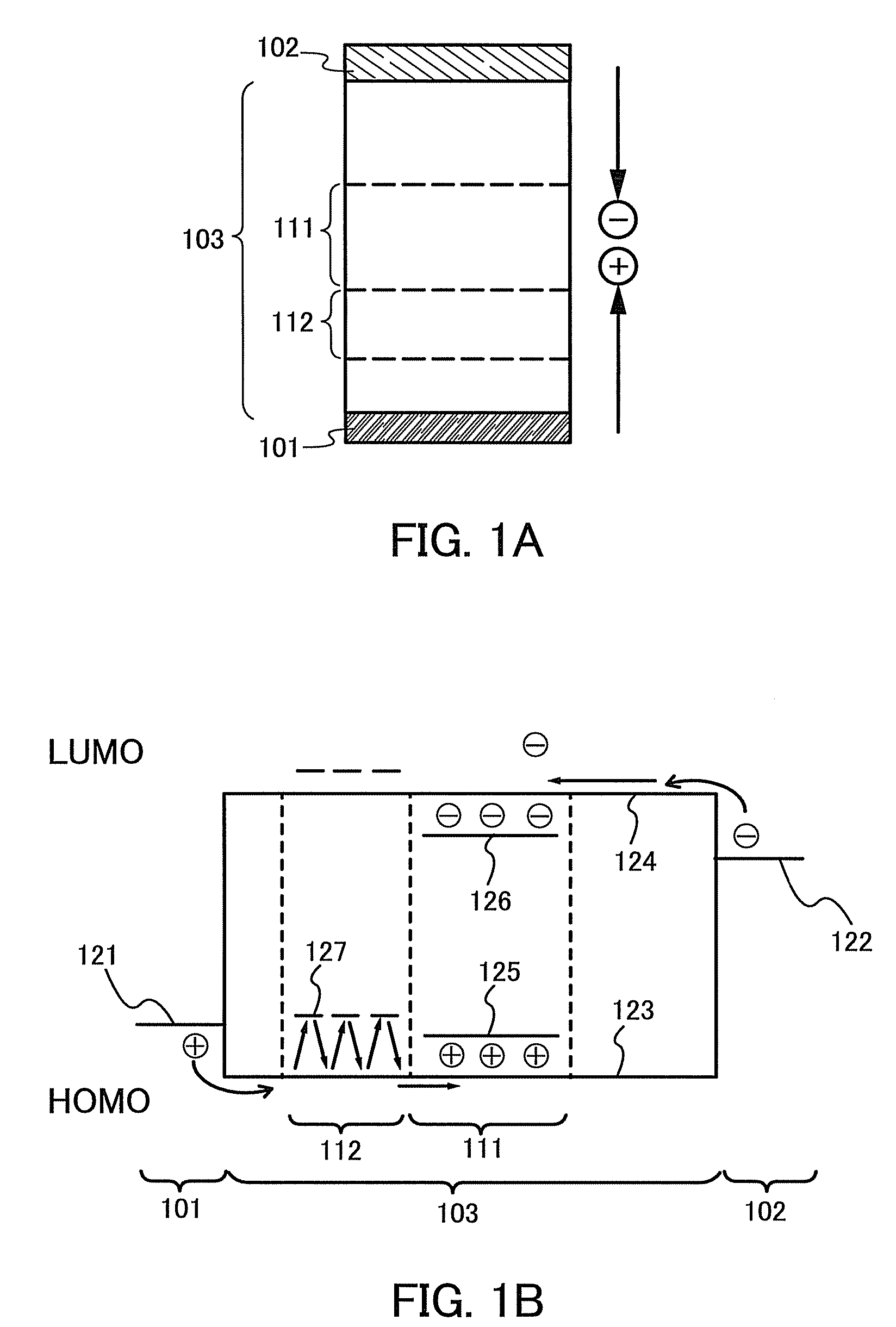Light-emitting element, light-emitting device, and electronic device
a light-emitting device and light-emitting element technology, applied in the direction of thermoelectric device junction materials, semiconductor devices, electrical apparatus, etc., can solve the problem of difficult to strike the carrier balance between electrons and holes with a single material, and achieve good carrier balance, high emission efficiency, and easy fabrication
- Summary
- Abstract
- Description
- Claims
- Application Information
AI Technical Summary
Benefits of technology
Problems solved by technology
Method used
Image
Examples
embodiment 1
[0093]In Embodiment 1, the concept and basic structure of the embodiment of the present invention will be described with reference to materials and fabrication methods which are used.
[0094]First, a case is considered where an organic compound film provided between an anode and a cathode contains a single organic compound (hereinafter, referred to as a first organic compound) and where a light-emitting substance is added to the organic compound film in order to control a light-emitting region and an emission color. This light-emitting region to which the light-emitting substance is added is preferably away from the anode and from the cathode so as to prevent quenching due to the electrode.
[0095]Many of organic compounds enable both holes and electrons to flow therethrough in a thin film state. In other words, in many cases, even a material that is generally called a hole-transport material enables electrons to flow therethrough, whereas even a material called an electron-transport ma...
embodiment 2
[0149]In Embodiment 2, another structure of an embodiment of the present invention which is obtained by development of the basic structure disclosed in Embodiment 1 will be described using FIGS. 4A and 4B and FIG. 5.
[0150]FIGS. 4A and 4B and FIG. 5 each illustrate a light-emitting element of an embodiment of the present invention which includes the organic compound film 103 containing the first organic compound between the anode 101 and the cathode 102; the organic compound film 103 is provided in contact with the anode 101 and with the cathode 102. Thus, the organic compound film 103 includes the light-emitting region to which the light-emitting substance is added and further includes the hole-transport region to which the hole-trapping substance is added and / or the electron-transport region to which the electron-trapping substance is added. The structures of these light-emitting region, hole-transport region, and electron-transport region are as disclosed in Embodiment 1.
[0151]In ...
embodiment 3
[0162]In Embodiment 3, another structure of an embodiment of the present invention which is obtained by development of the basic structure disclosed in Embodiment 1 will be described using FIGS. 6A and 6B and FIG. 7.
[0163]FIGS. 6A and 6B and FIG. 7 each illustrate a light-emitting element of an embodiment of the present invention which includes the organic compound film 103 containing the first organic compound between the anode 101 and the cathode 102, wherein the organic compound film 103 is provided in contact with the anode 101 and with the cathode 102. Thus, the organic compound film 103 includes the light-emitting region to which the light-emitting substance is added and further includes a hole-transport region to which a hole-trapping substance is added and / or an electron-transport region to which an electron-trapping substance is added. The structures of these light-emitting region, hole-transport region, and electron-transport region are similar to those disclosed in Embodi...
PUM
 Login to View More
Login to View More Abstract
Description
Claims
Application Information
 Login to View More
Login to View More - R&D
- Intellectual Property
- Life Sciences
- Materials
- Tech Scout
- Unparalleled Data Quality
- Higher Quality Content
- 60% Fewer Hallucinations
Browse by: Latest US Patents, China's latest patents, Technical Efficacy Thesaurus, Application Domain, Technology Topic, Popular Technical Reports.
© 2025 PatSnap. All rights reserved.Legal|Privacy policy|Modern Slavery Act Transparency Statement|Sitemap|About US| Contact US: help@patsnap.com



